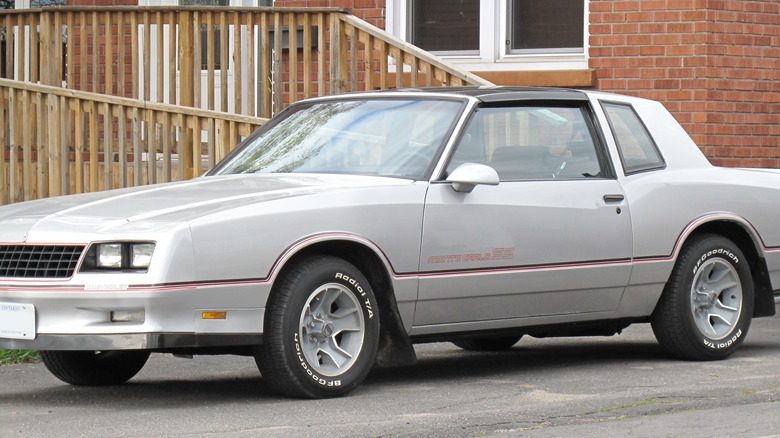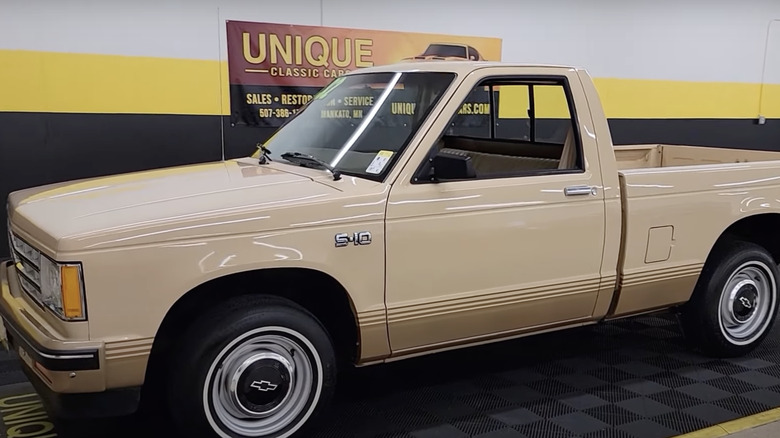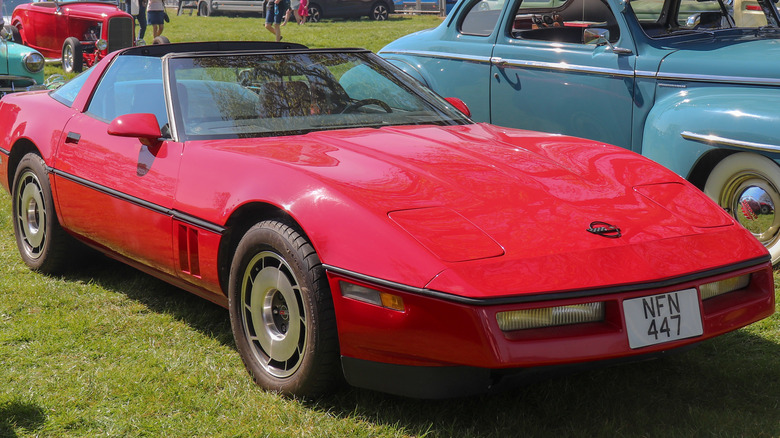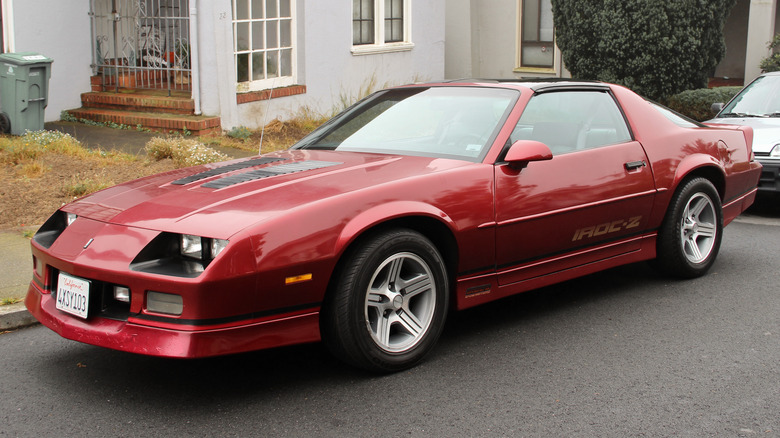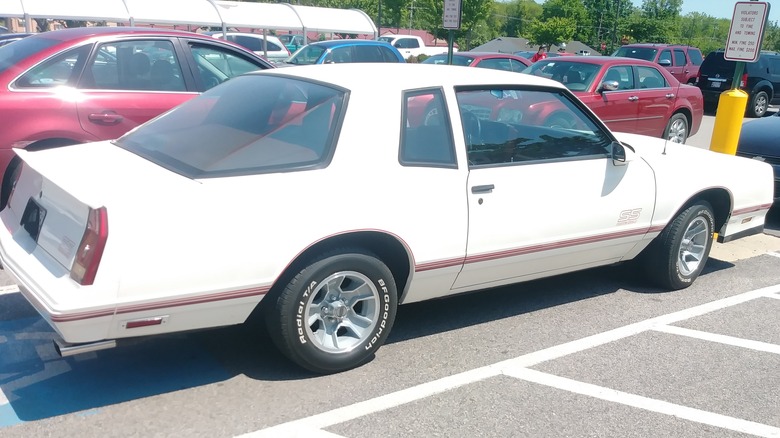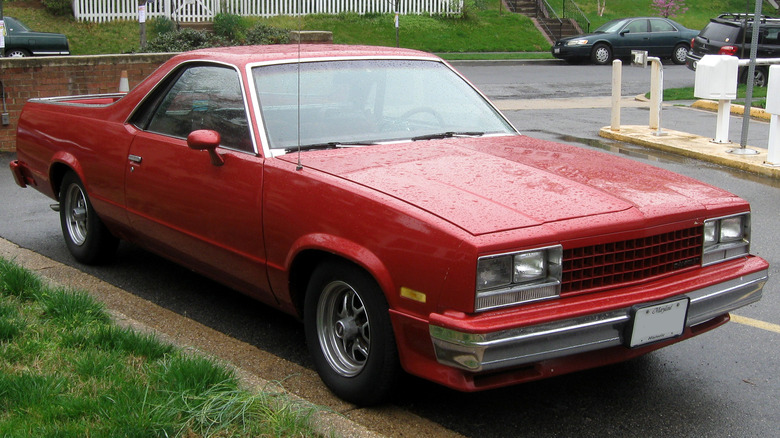5 Iconic Chevy Models From The 1980s
You don't have to be an automobile enthusiast or expert to appreciate the significance of the Chevrolet brand. Chevy was founded in 1911 by Belgian-born race driver Louis Chevrolet and William Durant, who had just been removed from his position as chairman of General Motors. The two men were familiar with each other from Chevrolet's time as a successful driver for Buick, the company Durant had managed in the century's early years. Chevy has produced more than 200 million vehicles since then, including the Suburban, which debuted in 1935 and has the longest uninterrupted production run of any vehicle in history.
The Chevrolet Suburban is currently in its twelfth generation and shares space on dealership lots with other familiar nameplates like the Malibu, Tahoe, Blazer, and Silverado. The 1980s were by no means prime years for U.S. automakers, who were still adjusting to major changes in the industry from the prior decade. These included a shift from leaded to unleaded gasoline that was mandated beginning in June of 1974 and Corporate Average Fuel Economy Standards, which were instituted in 1975.
The period from the mid-'70s to the mid-'80s is often referred to as the "malaise era," a term coined by industry journalist Murilee Martin. Although this period saw the production of some underwhelming vehicles, Chevy managed to crank out some models in the '80s that deserve recognition for their performance, styling, and cultural significance.
[Featured image by Elise240SX via Wikimedia Commons | Cropped and scaled | CC-BY 4.0]
The S-10 was the firs compact truck made in the United States
Years before the Silverado became America's second-best selling pickup truck, Chevy's S-10 (later the unhyphenated S10) helped usher U.S. buyers into buying smaller trucks. It debuted as a 1982 model, and was the first compact pickup truck to be designed and built solely by a U.S. manufacturer. It was built on the GMT325 platform shared with the Blazer, GMC Jimmy, and Oldsmobile Bravada. At first, it was only sold with a standard-sized cab, until the four-seat Maxicab hit the market in 1983, around the same time the S-10 Blazer replaced the previous K5 version.
The S-10's first generation covered the remainder of the 1980s, with the second generation premiering for the 1994 model year. That was the point at which the hyphen vanished from the model name. The S10 stayed in production in the United States through 2004, when the Colorado took its place. S-10 pickups from the 1980s remain popular with modders, particularly as the base for lowrider builds. If you're looking for a vintage truck that gets decent gas mileage and enjoys lots of aftermarket support, you can often find '80s S10 pickups for well under $10,000.
The '80s spanned two generations of the Corvette
The 1980s encompassed two of the Chevy Corvette's eight generations, with the C3 running through 1982 and the C4 debuting in 1984. The one-year gap in production in between came in part because of a transition from T-tops to a targa roof, which required a strengthening of the frame.
The 1984 'Vette was marred by the presence of the "Cross-Fire" version of the 350-cubic-inch V8, which had two throttle bodies and produced just 205 horsepower. The L98 version of the 350 graced the Corvette's engine bay beginning the next year, with a new electronic fuel injection system that helped boost engine output to 230 horsepower and 330 pound-feet of torque. The 1985 base model could hit a top speed of 150 miles per hour, making it the fastest standard-issue Corvette up to that point. The L98 got aluminum cylinder heads in 1986, shedding 40 pounds of bulk. A new valvetrain came the following year, helping the 1987 model sprint from 0 to 60 in 6.1 seconds.
C3 and C4 Corvettes look fast even while parked, and the model's recognizable wedge shape makes it popular with TV, film, and music video producers. Corvettes from the '80s were featured in contemporary shows "The A-Team" and "Miami Vice," as well as 1987 hit films "Roxanne" and "Robocop."
[Featured image by Vauxford via Wikimedia Commons | Cropped and scaled | CC-BY 4.0]
The Camaro IROC-Z was as '80s as the mullet and gold chains
The 1980s were the era of white Reeboks, big hair, and the Camaro IROC-Z, a special version of the Camaro Z/28 that was produced from 1985 to 1990. It took its moniker from the International Race of Champions, a series that drew top drivers from the world's various circuits and put them in identical cars to compete based on skill alone. The civilian version of the IROC-Z got 16-inch wheels, bold graphics on the doors, a rear spoiler, and aerodynamic side skirts. Originally, a 5.0-liter carbureted V8 was under the hood that produced a modest 157 horsepower, but in 1987 the engine options were expanded.
A fuel-injected 5.0-liter V8 made as much as 215 horsepower, and a version of Chevy's legendary 350-inch small block V8 made 225 horses. The 1987 IROC-Z's curb weight of nearly 3,300 pounds kept its 0 to 60 time to a respectable but not overwhelming 6.4 seconds. That was a tenth of a mile per hour slower than that year's 5.0-liter V8-powered Ford Mustang GT, which tipped the scales at 3,080 pounds. The IROC-Z suffered from the stereotype of being a car for the "Jersey Shore" crowd — decades before the show hit the airwaves — but that derision has faded as the world has become more accustomed to and even fond of the Snookis and Situations among us.
[Featured image by Nick Ares via Wikimedia Commons | Cropped and scaled | CC-BY 2.0]
The Monte Carlo SS had quintessentially '80s styling
While the IROC-Z was somewhat of a sheep in wolf's clothing, the Monte Carlo SS was a race car that anyone could buy. The fourth-generation Monte Carlo debuted in 1981, but that generation didn't get an SS version until 1983. (Previous versions of the Monte Carlo had received the SS treatment, but that trim had been on the shelf for a dozen years.) Although the 1984 SS was powered by a 5.0-liter V8 that only produced 175 horsepower, the generous body cladding and upgraded suspension, axles, and wheels helped Chevy sell more than 24,000 units of the Monte Carlo SS that year. In 1985, a new 4.3-liter V6 and an upgrade to the V8's carburetors helped boost sales by more than 10,000 units. Something special was coming for the next year.
At the time, the Monte Carlo was Chevy's representative in NASCAR, but the car wasn't as aerodynamic as its Ford Thunderbird competitors. In response, GM developed Aerocoupe versions of its G-body cars, the Monte Carlo and Pontiac Grand Prix. The twin models featured a fastback-style rear window and a shortened trunk lid to cut down on wind resistance. Motor Trend reports that Chevy sold about 6,000 Aerocoupes in 1987, but the next year, the Lumina replaced the Monte Carlo on the NASCAR circuit, and the Monte Carlo went on a five-year hiatus after the 1988 model year.
The El Camino's run ended in 1987
Another multi-generational Chevy model that had some memorable years in the 1980s was the El Camino. It was first introduced in 1959, but disappointing early sales cut that first generation short after two years. The El Camino was updated in 1964, 1968, and 1973. Then, a smaller fifth generation version appeared in 1978. Chevrolet discontinued the El Camino after the 1987 model year in part due to the success of the S10 pickup, although it still enjoyed a few final moments in the sun.
The El Camino's brief revival came despite the fact that the early '80s models were plagued by engine choices that included a 267-cubic-inch V8 that managed just 115 horsepower. Another option was the much-maligned Oldsmobile 350-inch diesel V8 that barely produced 100 horses. Fortunately, that engine was only used from 1982 through 1984, when buyers could also get a gas-fueled 305-inch V8 that made a respectable 145 horsepower.
With the muscle car era shrinking in the rear-view mirror, buyers had to be happy with the El Camino's distinctive styling and undeniable cool factor. A 1981 model was featured in 2019's "El Camino: A Breaking Bad Movie," which wrapped up the story of Jesse Pinkman (Aaron Paul) as he escapes from his white supremacist captors and flees to Alaska.
